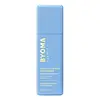What's inside
What's inside
 Key Ingredients
Key Ingredients

 Benefits
Benefits

 Concerns
Concerns

 Ingredients Side-by-side
Ingredients Side-by-side

Water
Skin ConditioningHamamelis Virginiana Water
AstringentGlycerin
HumectantCaprylic/Capric Triglyceride
MaskingPentaerythrityl Tetraethylhexanoate
EmollientSalicylic Acid
MaskingPolyglyceryl-3 Methylglucose Distearate
EmulsifyingPotassium Cetyl Phosphate
EmulsifyingEthyl Linoleate
EmollientPhenoxyethanol
PreservativePropanediol
SolventSodium Hydroxide
BufferingBakuchiol
AntimicrobialXanthan Gum
EmulsifyingPhytosphingosine
Skin ConditioningCeramide NP
Skin ConditioningCetearyl Alcohol
EmollientRutin
AntioxidantCarbomer
Emulsion StabilisingHydroxycinnamic Acid
Skin ConditioningEthylhexylglycerin
Skin ConditioningTocopherol
AntioxidantWater, Hamamelis Virginiana Water, Glycerin, Caprylic/Capric Triglyceride, Pentaerythrityl Tetraethylhexanoate, Salicylic Acid, Polyglyceryl-3 Methylglucose Distearate, Potassium Cetyl Phosphate, Ethyl Linoleate, Phenoxyethanol, Propanediol, Sodium Hydroxide, Bakuchiol, Xanthan Gum, Phytosphingosine, Ceramide NP, Cetearyl Alcohol, Rutin, Carbomer, Hydroxycinnamic Acid, Ethylhexylglycerin, Tocopherol
Salicylic Acid 0.5%
MaskingWater
Skin ConditioningCaprylic/Capric Triglyceride
MaskingPropanediol
SolventButylene Glycol
HumectantCetyl Ethylhexanoate
EmollientEthoxydiglycol
HumectantGlyceryl Stearate
Emollient1,2-Hexanediol
Skin ConditioningCetearyl Alcohol
EmollientCucumis Sativus Fruit Water
Skin ConditioningCentella Asiatica Extract
CleansingSodium Acetylated Hyaluronate
HumectantSodium Hyaluronate Crosspolymer
HumectantHydrolyzed Sodium Hyaluronate
Skin ConditioningSodium Hyaluronate
HumectantSclerotium Gum
Emulsion StabilisingMalpighia Emarginata Fruit Extract
Skin ConditioningGlycerin
HumectantAllantoin
Skin ConditioningSodium Benzoate
MaskingPotassium Hydroxide
BufferingSodium Phytate
Niacinamide
SmoothingPolyacrylate Crosspolymer-6
Emulsion StabilisingCitric Acid
BufferingEthylhexylglycerin
Skin ConditioningT-Butyl Alcohol
PerfumingPentylene Glycol
Skin ConditioningSodium Polyacrylate
AbsorbentSalicylic Acid 0.5%, Water, Caprylic/Capric Triglyceride, Propanediol, Butylene Glycol, Cetyl Ethylhexanoate, Ethoxydiglycol, Glyceryl Stearate, 1,2-Hexanediol, Cetearyl Alcohol, Cucumis Sativus Fruit Water, Centella Asiatica Extract, Sodium Acetylated Hyaluronate, Sodium Hyaluronate Crosspolymer, Hydrolyzed Sodium Hyaluronate, Sodium Hyaluronate, Sclerotium Gum, Malpighia Emarginata Fruit Extract, Glycerin, Allantoin, Sodium Benzoate, Potassium Hydroxide, Sodium Phytate, Niacinamide, Polyacrylate Crosspolymer-6, Citric Acid, Ethylhexylglycerin, T-Butyl Alcohol, Pentylene Glycol, Sodium Polyacrylate
 Reviews
Reviews

Ingredients Explained
These ingredients are found in both products.
Ingredients higher up in an ingredient list are typically present in a larger amount.
This ingredient is an emollient, solvent, and texture enhancer. It is considered a skin-softener by helping the skin prevent moisture loss.
It helps thicken a product's formula and makes it easier to spread by dissolving clumping compounds.
Caprylic Triglyceride is made by combining glycerin with coconut oil, forming a clear liquid.
While there is an assumption Caprylic Triglyceride can clog pores due to it being derived from coconut oil, there is no research supporting this.
Learn more about Caprylic/Capric TriglycerideCetearyl alcohol is a mixture of two fatty alcohols: cetyl alcohol and stearyl alcohol. It is mainly used as an emulsifier. Emulsifiers help prevent the separation of oils and products. Due to its composition, it can also be used to thicken a product or help create foam.
Cetearyl alcohol is an emollient. Emollients help soothe and hydrate the skin by trapping moisture.
Studies show Cetearyl alcohol is non-toxic and non-irritating. The FDA allows products labeled "alcohol-free" to have fatty alcohols.
This ingredient is usually derived from plant oils such as palm, vegetable, or coconut oils. There is debate on whether this ingredient will cause acne.
Due to the fatty acid base, this ingredient may not be Malassezia folliculitis safe.
Learn more about Cetearyl AlcoholEthylhexylglycerin (we can't pronounce this either) is commonly used as a preservative and skin softener. It is derived from glyceryl.
You might see Ethylhexylglycerin often paired with other preservatives such as phenoxyethanol. Ethylhexylglycerin has been found to increase the effectiveness of these other preservatives.
Glycerin is already naturally found in your skin. It helps moisturize and protect your skin.
A study from 2016 found glycerin to be more effective as a humectant than AHAs and hyaluronic acid.
As a humectant, it helps the skin stay hydrated by pulling moisture to your skin. The low molecular weight of glycerin allows it to pull moisture into the deeper layers of your skin.
Hydrated skin improves your skin barrier; Your skin barrier helps protect against irritants and bacteria.
Glycerin has also been found to have antimicrobial and antiviral properties. Due to these properties, glycerin is often used in wound and burn treatments.
In cosmetics, glycerin is usually derived from plants such as soybean or palm. However, it can also be sourced from animals, such as tallow or animal fat.
This ingredient is organic, colorless, odorless, and non-toxic.
Glycerin is the name for this ingredient in American English. British English uses Glycerol/Glycerine.
Learn more about GlycerinPropanediol is an all-star ingredient. It softens, hydrates, and smooths the skin.
It’s often used to:
Propanediol is not likely to cause sensitivity and considered safe to use. It is derived from corn or petroleum with a clear color and no scent.
Learn more about PropanediolSalicylic Acid (also known as beta hydroxy acid or BHA) is a well-known ingredient for treating skin that struggles with acne and clogged pores. It exfoliates both the skin's surface and deep within the pores to help clear out buildup, control oil, and reduce inflammation.
Unlike AHAs (alpha hydroxy acids), salicylic acid is oil-soluble. This allows it to penetrate into pores which makes it especially effective for treating blackheads and preventing future breakouts.
Salicylic acid is also known for its soothing properties. It has a similar structure to aspirin and can calm inflamed or irritated skin, making it a good option for acne-prone skin that is also sensitive.
Concentrations of 0.5-2% are recognized by the U.S. FDA as an over-the-counter topical acne product.
It can cause irritation and/or dryness if one's skin already has a compromised moisture barrier, so it's best to focus on repairing that before introducing this ingredient into your routine.
While salicylic acid does not increase sun sensitivity, it’s still important to wear sunscreen daily to protect your skin.
If you are looking for the ingredient called BHA or Butylated Hydroxyanisole, click here.
Learn more about Salicylic AcidWater. It's the most common cosmetic ingredient of all. You'll usually see it at the top of ingredient lists, meaning that it makes up the largest part of the product.
So why is it so popular? Water most often acts as a solvent - this means that it helps dissolve other ingredients into the formulation.
You'll also recognize water as that liquid we all need to stay alive. If you see this, drink a glass of water. Stay hydrated!
Learn more about Water